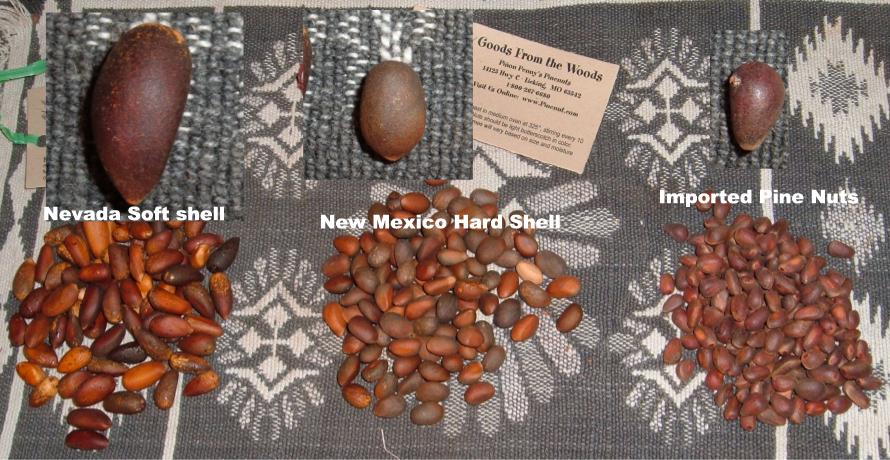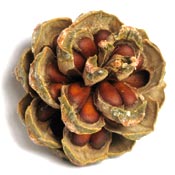How to grow your own pine nuts and save money on the price of pine nuts
Information on growing Pine Trees for Pine Nuts from Pine Nut Expert Pinon Penny Pinenut.com
What are pine nuts - Pining to know

Seeds of various pine trees pictured above
Pines are coniferous trees of the genus Pinus, in the family Pinaceae. There are about 115 species of pine, although different authors accept anything between about 105 to 125 species.
Pine trees (Pinus) have the wonderful distinction of being adaptable to wide ranges. Depending on the variety, they will grow in climatic Zones 1 to 10 inclusive. They are able to grow in soils ranging from wet clay to sandy loam.
They fulfill many multiple uses, not only in providing a bountiful harvest of edible nut pines and aromatic cones which are sold at prices that make them a worthwhile commercial crop that will out produce cereal crops and other methods of farming operations based on their cash return per acre.
They also lend to the landscaping business which rival other conifer trees with their beautiful foliage of light greens to bluish colouring. They are one of the main crops for many animals. Coming in multiply choices ranging from 200 feet tall trees to bushes that reach a maximum height of 10 feet, their lifespan range from 150 years and over. Once established, the trees may start production as early as 8 years from seed and they will continue production for their lifespan. They require minimum maintenance and we have not encountered any pests to date.
An important common species pine nut is the seed of Pinus pinea. Two other species, P. sabiniana and P. coulteri, produce large cones however they slower growing and the pine nut seed has a lower oil content than P. pinea. Pinus pinea, is often called the 'Stone Pine' and sometimes the 'Umbrella Nut'. These names originate from the observation that these trees grow well in stony ground. They also grow in an umbrella shape.
The tree is fairly easy propagated from seed, preferably fresh seed. However, fresh seed is hard to come by, as most pine nuts have been shelled and dehydrated. One client wrote, "I tried planting the "pine nuts" available for making pesto, etc - but they rapidly dissolve." Opps.... This is one of the reasons, I asked Charles Rhora to contribute to our page. He has been growing pine nut trees for 30 years, with amazing success. His banner is on the top of this page. I highly recommend you visit his site, http://www.nuttrees.com. (By the way, this is NOT a paid advertisement)
The temperature for seed germination is about 17-19C. If temperatures are above 25C seedling establishment will be inhibited. Temperatures below about 10C create seed dormancy. The best germination is obtained following planting in coarse river sand or pumice with about 25% moisture. As with most seeds, they will rot if the soil is too wet. It is important to add mycorrhizal fungus gathered from under a stand of other pine trees, because in the absence of the fungi the trees are likely to suffer phosphorous deficiency and make poor growth. Once established, the young pine nut trees should not be over-watered. Once the nut shell has fallen, you may replant into deeper containers. One must be careful toCare avoid breaking the tap root .
PURCHASE AMERICAN PINE NUT SEEDS FOR GERMINATION
We carry live raw P. Monophylla seeds (apx 1,500 per pound $13.00) and P. Edulis (2,300 seeds per lb $19.95 )
Purchase American Pine Nut Seedlings:
(please help us find a good U.S. resource, email me penny@pinenut.com )
American species of pine nut trees be expected to start producing cones from about year 10 years. However, on poor soils production may not start until about year 12. In Europe the annual yield of nuts is about 500 kg/ha. Each cone holds about 50 nuts and 100 kg of cones holds about 20 kg of nuts. Prune the trees after 3 years to remove all the lower branches. Clearing lower branches facilitates the production and harvesting of the nuts. Studies undertaken in Italy on the effects of grafting which is being done with the object of producing more cones and better nuts. The preferred graft is a cleft graft done in mid-summer, although veneer side grafting is also practiced. The rootstock used for grafting must be at least two years old otherwise delayed mortality occurs about two years after grafting. In addition to P. pinea the rootstocks used include P. radiata (80-85% success), P. halepensis and P. sabiana (60-70% success) and P. pinaster (20-50%).
How to work with established pinon trees for nut production:
If you live in an area of the American Southwest and own land with Pinyon Trees, please review, http://www.pinonnuts.org for information on managing your land for pine nut production. Goods From The Woods works with private land owners in purchasing pinon nuts and helping develop the pine nut industry in the United States.
Also - I am a believer in having the nurse plants for young pinyon trees albeit there is conflict in the research. Here are some additional resources for growing pinyon trees (P. Monophylla)




